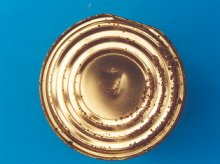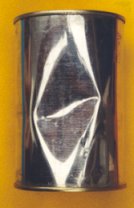Foodstuffs, such as fruit, vegetables, meat, fish, soups and ready meals, which are preserved by sterilization in cans of tin or black plate, glass or composite films, are known as preserved foods. Sterilization at temperatures of 115 - 120°C kills most microorganisms, even heat-resistant spores. Air-tight closure prevents the sterilized contents from falling prey to microorganisms again. After sterilization, preserved foods are cooled and labeled. Cartons containing preserved foods are generally packed into containers on pallets.
Semi-preserved foods are those which have been preserved without sterilization and using acids or chemical preservatives, e.g. caviar, fish marinades etc..
Preserved foods are goods displaying 4th order biotic activity (BA 4), i.e. they are goods in which biochemical and microbial processes have stopped and which are isolated from the external environment, as are sterilized and pasteurized goods in hermetically sealed packaging.
Owing to this packaging, they are assigned to water content class 0 (WCC 0) like beverages.
Preserved foods require particular temperature, humidity/moisture and possibly ventilation conditions (SC VI). They suffer in particular from temperature-determined physical changes (expansion/dilatation), which lead to heat- and cold-induced blowing. Excessive humidity leads to corrosion damage.
If the product, packaging, pallets and container floor are container dry, they can be transported in standard containers. Depending on the season and the route and duration of the voyage, refrigerated containers may also be necessary.
Transport instructions and damage
Standard containers containing preserved foods require cool slots. At relative humidities of > 70%, wetting may result in corrosion and in labels falling off. If freezing point is reached, ice expansion rupture must be expected, while temperatures > 20°C should be avoided due to the risk of heat expansion rupture. Heat-induced blowing is most frequently observed in the area of the container ceiling.
When packing the container, the packaging should be checked for intactness (risk of theft). Cartons of wet strength paperboard are preferred. The cartons should be secured with tear-resistant adhesive strips. An effective method of protecting them from moisture is to form cargo units wrapped in shrink films.
- Blowing
The most frequent types of damage suffered by cans are swelling, known as "blowing", and corrosion. After sterilization, gas formation may cause can walls to deform and the tops and bottoms to bulge. So much gas may form that the seams may ultimately tear open and the cans burst (see Fig. 162). This phenomenon is known as blowing. The contents of blown containers are inedible or hazardous to health.

Figure 162: Blown can: side seam torn open
- Corroded cans
The water content of the packaging has a considerable influence on the susceptibility of preserved food cans to corrosion. If the water content of the paperboard cartons is > 8% and that of the wooden boxes is > 12%, incidents of loss arise time and again because the cans corrode and the labels fall off. Mold and mildew formation often occur because excessively green lumber with water contents of 18 to ≤30% has been used to make the boxes.

Figure 163: Bottom of a can with pitting corrosion;
Photo: U. Scharnow
Cartons which have inadequate strength are frequently damaged when stowed and secured inadequately in the container, so resulting in denting and squashing of the cans. If the contents of the cans leaks out, the cartons become soft and the carton stacks may collapse. Jars and large cans should be packed in compartmentalized cartons (see Figs. 164, 165).
 |
 |
Figures 164 and 165: Dented cans
Photos: U. Scharnow
Photos: U. Scharnow